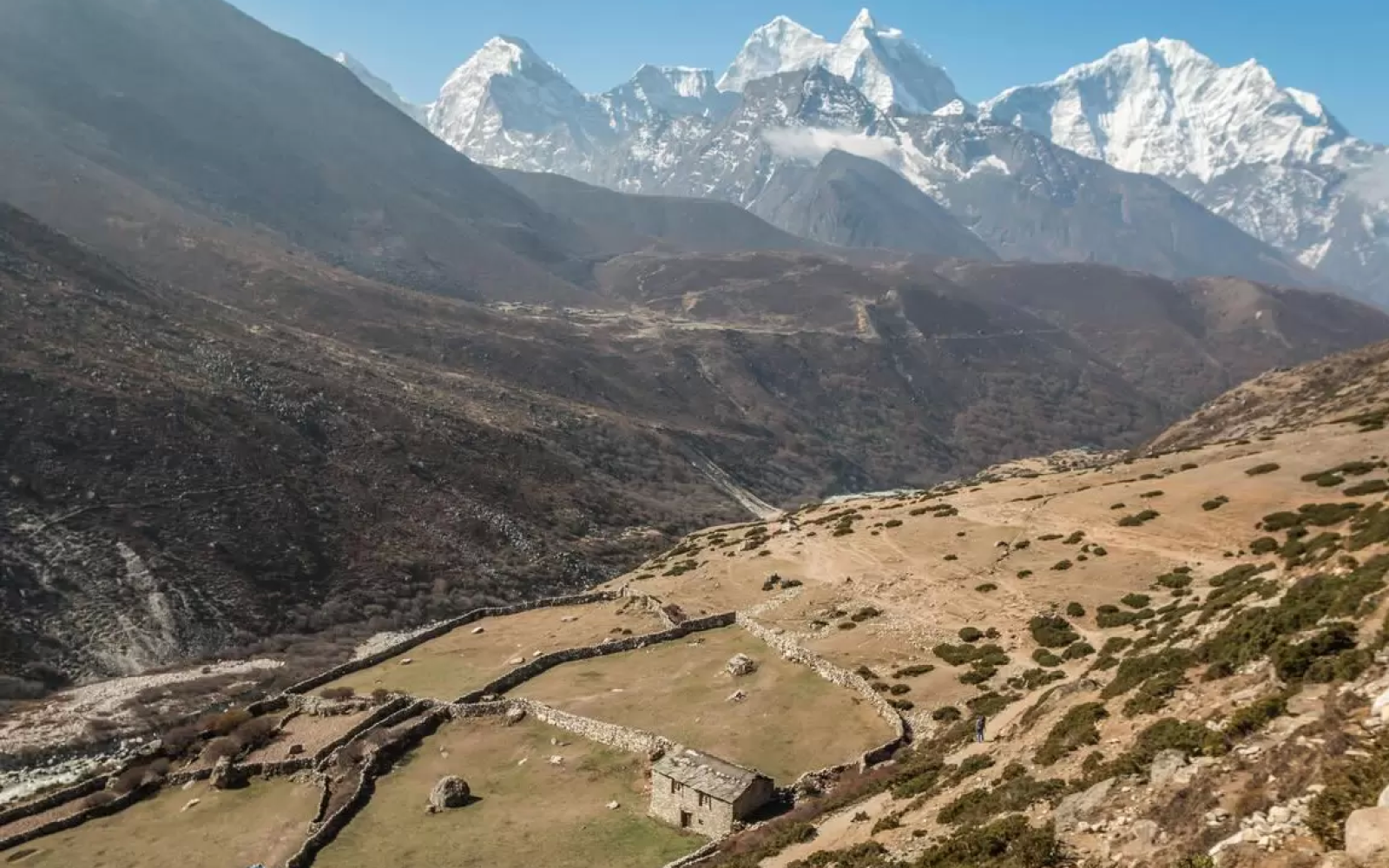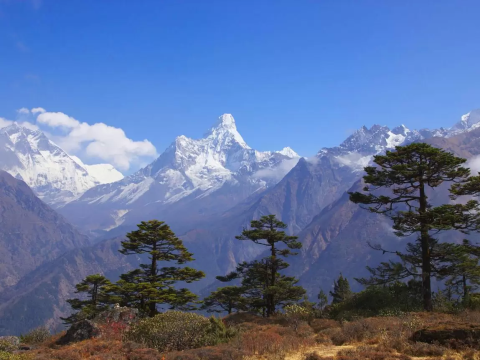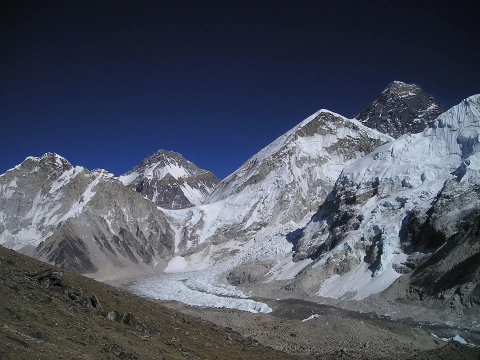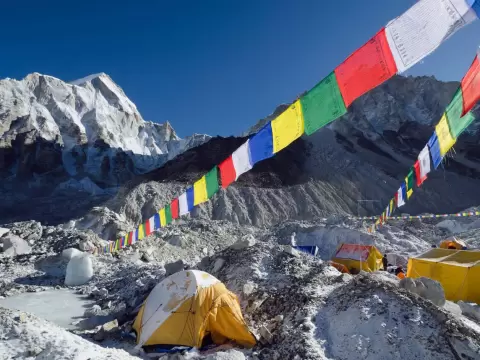How to Choose the Right Everest Base Camp Trek Route
Choosing the right route for your Everest Base Camp (EBC) trek is an important decision that can sha...

The Everest Base Camp Trek is one of the most iconic and exhilarating treks in the world. Taking on this journey with Himalayan Forever Treks offers you the unique opportunity to experience the grandeur of the Himalayas while enjoying exceptional service and support throughout the expedition. May is an ideal time for this trek, as it sits right before the monsoon season and just after the pre-monsoon showers, making it a prime period for clear skies and relatively mild temperatures. During May, trekkers can enjoy a perfect balance of optimal weather conditions, stunning views of Everest and its surrounding peaks, and fewer crowds compared to the peak trekking season in autumn. Himalayan Forever Treks ensures that every step of your journey is safe, well-guided, and memorable.
In addition to the beautiful weather, May also provides trekkers with an opportunity to witness the cultural richness of Nepal. The trek is not just a physical journey but also an immersion into the vibrant Sherpa culture and the stunning monasteries that line the route. With Himalayan Forever Treks, the focus is on ensuring that you get the most out of both the natural beauty and cultural heritage of the Everest region. The trek is ideal for those looking to enjoy both adventure and cultural immersion in one of the most spectacular environments on earth.
May is considered one of the best months for trekking to Everest Base Camp due to the favorable weather and conditions. As spring settles into the region, temperatures are moderate compared to the harsher winter months, allowing trekkers to comfortably hike at high altitudes. The trekking trails are surrounded by lush greenery, and wildflowers are in full bloom, offering stunning vistas that contrast against the towering snow-capped peaks of the Himalayas. The weather is usually stable with clear skies, giving trekkers the chance to enjoy unobstructed views of Mount Everest and the surrounding peaks.
Moreover, trekking in May gives you the advantage of avoiding the thick crowds that swarm the Everest region during peak trekking seasons, such as October. With Himalayan Forever Treks, you can trek at your own pace, enjoy the peaceful environment, and fully experience the beauty of the Khumbu Valley. Additionally, May is a time when mountaineers are preparing for their summit attempt on Everest, so you'll be able to feel the buzz of excitement as you make your way to Base Camp, perhaps even witnessing climbers at various stages of their journey. The trekking experience in May is truly one of a kind, offering a rare combination of beauty, tranquility, and a touch of adventure.
Trekking to Everest Base Camp in May also coincides with the Nepali New Year, which typically falls in the first week of April but continues to be celebrated well into May in some areas. This cultural event is a festive and joyful time in Nepal, and many locals, particularly in the Sherpa villages along the Everest trail, take part in various traditional celebrations. During this period, you'll have the chance to witness local customs, dances, and celebrations that add a unique and colorful dimension to your trek. The festive atmosphere of Nepali New Year makes your trek even more special, offering you a chance to connect with the local culture in a way that enhances your overall trekking experience.
In addition to the festivities, Nepali New Year provides trekkers with an opportunity to witness the strong sense of community and hospitality that Nepal is famous for. The villages are vibrant with decorations, and you may be invited to join in the celebrations with local families. With Himalayan Forever Treks, you'll have the advantage of local guides who are deeply connected to the communities in the region, ensuring an authentic and respectful cultural experience. The joyous occasion adds a sense of warmth and connection to your journey, making it an unforgettable part of your Everest Base Camp trek in May.
May is one of the most favorable months in terms of weather for trekking to Everest Base Camp. The temperatures are relatively mild compared to the freezing cold of the winter months, with daytime temperatures in lower altitudes ranging from 10°C to 15°C (50°F to 59°F). As you ascend to higher altitudes, temperatures can drop, especially at night, with nighttime temperatures at Base Camp potentially falling to around -5°C to -10°C (23°F to 14°F). However, these temperatures are manageable for trekkers who are properly prepared with appropriate clothing. The clear skies and sunshine typical of May provide trekkers with stunning panoramic views of Mount Everest, Lhotse, Nuptse, and other surrounding peaks.
Rainfall is minimal in May, which means there’s less chance of heavy showers disrupting your trek, as the monsoon season typically starts later in June. The dry weather, combined with the moderate temperatures, allows for a more comfortable and enjoyable trekking experience. With Himalayan Forever Treks, you'll receive expert guidance on how to dress for varying temperatures, ensuring you're prepared for both the sunny lower altitudes and the chilly nights at Base Camp. The dry conditions also reduce the risk of slippery trails, making May an excellent month for both novice and experienced trekkers to safely complete the trek to Everest Base Camp.
Advantages of Trekking EBC in May
Trekking to Everest Base Camp in May comes with several benefits that make it one of the best months for the adventure. The most significant advantage is the stable weather and clear skies, allowing trekkers to enjoy breathtaking views of Mount Everest, Lhotse, Nuptse, and other towering peaks. The moderate daytime temperatures make trekking more comfortable, unlike the freezing winter months or the unpredictable monsoon season. Another major advantage is the vibrant landscapes—spring brings lush greenery and blooming rhododendrons, creating a picturesque trekking route.
May is also the peak climbing season for Everest summit expeditions, meaning trekkers can witness the excitement and energy of mountaineers preparing for their final ascent. The trails are lively but not as crowded as the autumn season, allowing for a more peaceful experience. Additionally, cultural experiences such as the Nepali New Year and Buddhist festivals in the Everest region enhance the trek, offering an opportunity to engage with local traditions and customs.
Disadvantages of Trekking EBC in May
Despite its many advantages, trekking in May also has some challenges. One of the main drawbacks is the increased number of trekkers compared to the quieter winter months, which means tea houses and lodges may be busier. This can lead to limited availability of rooms, especially in higher-altitude villages like Dingboche and Gorak Shep. It’s advisable to book accommodations in advance through a reputable trekking company like Himalayan Forever Treks to avoid last-minute inconveniences.
Another disadvantage is that while May is generally dry, weather at higher altitudes can still be unpredictable. Occasional pre-monsoon showers may occur, making trails slightly muddy. Also, altitude-related challenges remain a concern, as the body takes time to acclimatize to the thinning air. Proper acclimatization and hydration are crucial to avoiding altitude sickness.
Preparing for the Everest Base Camp Trek requires physical fitness, mental resilience, and proper planning. Since trekking in May involves long hours of walking at high altitudes, physical conditioning is essential. Trekkers should engage in cardiovascular exercises like hiking, running, cycling, and stair climbing at least 2-3 months in advance. Strength training, focusing on legs and core, also helps in endurance and balance on rugged trails. Practicing with a backpack similar to what you will carry on the trek is advisable to get used to the weight.
Beyond fitness, proper logistical preparation is crucial. Booking the trek through a trusted company like Himalayan Forever Treks ensures well-planned itineraries, expert guides, and necessary permits. Additionally, trekkers should prepare for varying temperatures by packing appropriate gear, including layered clothing, waterproof items, and comfortable trekking boots. Travel insurance covering high-altitude trekking is a must, as it ensures safety in case of emergencies.
Altitude sickness, or Acute Mountain Sickness (AMS), is a common challenge when trekking to Everest Base Camp due to the rapid gain in elevation. Symptoms include headaches, nausea, dizziness, and shortness of breath. To minimize the risk, proper acclimatization is crucial. Trekkers should follow the golden rule: "Climb high, sleep low," which means ascending gradually and allowing time for the body to adjust. The standard itinerary includes at least two acclimatization days in Namche Bazaar and Dingboche.
Hydration plays a key role in avoiding altitude sickness, so trekkers should drink at least 3-4 liters of water daily. Avoiding alcohol and smoking helps maintain oxygen levels in the body. Additionally, eating a high-carbohydrate diet provides necessary energy for trekking. Some trekkers also take Diamox (Acetazolamide), a medication that helps with acclimatization, but it should only be used after consulting a doctor. With the experienced guides of Himalayan Forever Treks, trekkers receive proper guidance on altitude management, ensuring a safe and enjoyable journey.
Packing the right gear and clothing is essential for a successful Everest Base Camp Trek in May. Since temperatures vary from warm daytime conditions in lower altitudes to freezing nights at Base Camp, layered clothing is the best approach. Essential clothing items include:
Other essential trekking gear includes trekking poles, a good-quality sleeping bag (-10°C rated), a headlamp with extra batteries, UV-protection sunglasses, and a backpack with a rain cover. Packing snacks, sunscreen, lip balm, and a first-aid kit is also necessary. Trekking with Himalayan Forever Treks ensures proper packing advice and assistance, making sure you have everything needed for a smooth trek.
Before starting the Everest Base Camp Trek, trekkers must obtain the required permits. As of 2025, the two main permits needed are:
Additionally, if trekking from Jiri or Salleri instead of flying to Lukla, a Gaurishankar Conservation Area Permit is required. Trekking with Himalayan Forever Treks ensures that all necessary permits are arranged in advance, avoiding any last-minute hassles.
It is also advisable to carry a valid passport, passport-sized photos, and travel insurance documents (covering high-altitude rescue). Keeping digital and printed copies of all permits and documents ensures smooth passage through various checkpoints along the trekking route.
By properly preparing with the right permits, fitness training, gear, and altitude awareness, your Everest Base Camp Trek in May will be an unforgettable and rewarding adventure. With Himalayan Forever Treks, you can embark on this journey with expert guidance, ensuring a safe, enjoyable, and culturally enriching experience in the heart of the Himalayas.
There are several itinerary options for trekking to Everest Base Camp in May, each offering unique experiences and challenges. Whether you prefer a standard trek, an extended adventure with high-altitude passes, or a luxurious return by helicopter, there is an itinerary to suit different preferences and fitness levels. Himalayan Forever Treks provides well-organized itineraries, ensuring safety, comfort, and a memorable journey in the Everest region.
1. Everest Base Camp Trek (12-14 Days)
This is the classic Everest Base Camp trek, ideal for trekkers who want to experience the breathtaking landscapes, rich Sherpa culture, and the thrill of reaching the base of the world’s highest mountain. The journey begins with a flight to Lukla, followed by trekking through Phakding, Namche Bazaar, Tengboche, Dingboche, Lobuche, and finally Everest Base Camp and Kala Patthar. Two acclimatization days are built in at Namche Bazaar and Dingboche to reduce the risk of altitude sickness. The return follows the same route, with a gradual descent back to Lukla before flying to Kathmandu.
2. Everest Three Passes Trekking (18-21 Days)
For adventure seekers, the Everest Three Passes Trek is a challenging and rewarding circuit covering Kongma La Pass (5,535m), Cho La Pass (5,420m), and Renjo La Pass (5,360m). This trek includes all the highlights of the classic Everest Base Camp trek but adds three spectacular high passes, Gokyo Lakes, and the remote beauty of the Everest region. It is best suited for experienced trekkers looking for an ultimate Himalayan adventure.
3. Gokyo with Everest Base Camp via Cho-La Pass (16-18 Days)
This trek offers a stunning alternative to the traditional route by combining the Gokyo Valley and its pristine turquoise lakes with the Everest Base Camp trek via Cho-La Pass (5,420m). Trekkers will witness the breathtaking Ngozumpa Glacier, hike up to Gokyo Ri (5,357m) for panoramic views, and then cross the challenging Cho-La Pass before joining the classic Everest trail. This route is perfect for those who want fewer crowds and a more scenic journey.
4. Everest Trek Return by Helicopter (8-10 Days)
For those who want a shorter and more comfortable adventure, the Everest Base Camp trek with a helicopter return offers the best of both worlds. Trekkers follow the standard route up to Everest Base Camp and Kala Patthar, then return to Kathmandu by helicopter instead of trekking back. This option allows trekkers to save time while enjoying aerial views of the Himalayas, making it a luxurious and efficient choice.
5. Everest Short Trek (5-7 Days)
If you are short on time but still want to experience the beauty of the Everest region, the Everest Short Trek is an excellent choice. The trek typically goes up to Namche Bazaar or Tengboche, offering incredible views of Everest without requiring a long commitment. This trek is ideal for beginners, families, or those looking for a less strenuous introduction to the Khumbu region.
The Everest Base Camp trek is an unforgettable journey that offers a perfect mix of natural beauty, cultural immersion, and personal achievement. Some of the most exciting highlights include:
May brings additional perks to the Everest Base Camp trek, making it even more special. Some exclusive highlights of trekking during this month include:
During the Everest Base Camp trek in May, accommodation is mainly in teahouses or lodges, which offer basic but comfortable rooms with twin beds, blankets, and communal dining areas. In lower altitudes like Namche Bazaar, you can find more luxurious lodges with hot showers, Wi-Fi, and charging facilities. However, as you ascend, amenities become more limited, and rooms may need to be shared due to high demand. Booking in advance through Himalayan Forever Treks ensures better accommodation options.
Regarding food, teahouses offer a variety of meals, including dal bhat (rice and lentils), noodles, soups, and Tibetan bread. Drinking water is available, but it's best to carry a reusable bottle and water purification tablets to reduce plastic waste. Porters and yaks help carry luggage, allowing trekkers to walk with a lighter backpack.
By following these tips and choosing a reputable trekking company like Himalayan Forever Treks, you can ensure a safe, comfortable, and unforgettable Everest Base Camp trek in May.
Health and safety are crucial when trekking to Everest Base Camp, especially at high altitudes where the risk of altitude sickness (AMS), dehydration, and exhaustion increases. Fortunately, several health posts and medical facilities are available along the trail to provide emergency assistance.
In case of severe altitude sickness, dehydration, or injuries, helicopter evacuations are available (if covered by travel insurance). Trekking with Himalayan Forever Treks ensures that you have expert guides trained in first aid and altitude sickness management, providing extra safety throughout your journey.
While May is one of the best months for the Everest Base Camp trek, it comes with its own set of challenges. Being well-prepared and mentally ready can help overcome these difficulties.
1. High Altitude and AMS (Acute Mountain Sickness)
One of the biggest challenges is adjusting to the low oxygen levels at high altitudes. Symptoms like headache, dizziness, nausea, and shortness of breath can occur if you ascend too quickly. To avoid AMS:
2. Busy Trails and Limited Accommodation
May is a popular trekking month, meaning teahouses can fill up quickly. To avoid issues:
3. Unpredictable Weather at High Altitudes
While May generally offers clear skies and stable weather, occasional pre-monsoon showers can occur. To prepare:
By preparing adequately, you can enjoy the beauty of the Himalayas while minimizing risks.
If you’re looking for alternative treks that offer stunning Himalayan views but with different challenges or fewer crowds, here are some great options:
1. Annapurna Base Camp (ABC) Trek
2. Langtang Valley Trek
3. Manaslu Circuit Trek
4. Gokyo Lakes Trek
Choosing the right trekking company is essential for a safe, enjoyable, and hassle-free journey. Himalayan Forever Treks is a top choice for several reasons:
With Himalayan Forever Treks, you can embark on the Everest Base Camp trek with confidence, knowing you are in safe and experienced hands.
Trekking to Everest Base Camp in May is a once-in-a-lifetime adventure filled with breathtaking landscapes, cultural richness, and personal achievement. With stable weather, clear views, and blooming rhododendrons, May is one of the best times to embark on this incredible journey. However, challenges such as altitude sickness, busy trails, and unpredictable weather require careful preparation.
By choosing Himalayan Forever Treks, you can experience the beauty of the Everest region with expert guidance, safety, and unmatched hospitality. Whether you opt for the classic trek, a helicopter return, or an alternative Himalayan route, our team ensures that your journey is safe, comfortable, and unforgettable.
Are you ready to conquer Everest Base Camp this May? Let Himalayan Forever Treks guide you to the adventure of a lifetime!

Choosing the right route for your Everest Base Camp (EBC) trek is an important decision that can sha...

The Everest Base Camp (EBC) Trek is one of the most iconic trekking routes in the world, drawing adv...

The Everest Base Camp (EBC) trek in April is one of the most sought-after treks in Nepal, as it is d...
